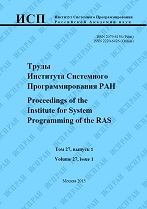|
Formal rules to produce object notation for EXPRESS schema-driven data
V. A. Semenovabc, S. V. Arishinb, G. V. Semenovd
a HSE University
b Ivannikov Institute for System Programming of the Russian Academy of Sciences
c Moscow Institute of Physics and Technology
d ITMO University
Abstract:
Recently, product data management systems (PDM) are widely used to conduct complex multidisciplinary projects in various industrial domains. The PDM systems enable teams of designers, engineers, and managers to remotely communicate on a network, exchange and share common product information. To integrate CAD/CAM/CAE applications with the PDM systems and ensure their interoperability, a dedicated family of standards STEP (ISO 10303) has been developed and employed. The STEP defines an object-oriented language EXPRESS to formally specify information schemas as well as file formats to store and transfer product data driven by these schemas. These are clear text encoding format SPF and STEP-XML. Nowadays, with the development and widespread adoption of Web technologies, the JSON language is getting increasingly popular due to it being apropos for the tasks of object-oriented data exchange and storage, as well as its simple, easy to parse syntax. The paper explores the topic of the suitability of the JSON language for the unambiguous representation, storage and interpretation of product data. Under the assumption that the product data can be described by arbitrary information schemas in EXPRESS, formal rules for the producing JSON notation are proposed and presented. Explanatory examples are provided to illustrate the proposed rules. The results of computational experiments conducted confirm the advantages of the JSON format compared to SPF and STEP-XML, and motivate its widespread adoption when integrating software applications.
Keywords:
object-oriented modeling, system integration, interoperability, STEP, EXPRESS, JSON.
Citation:
V. A. Semenov, S. V. Arishin, G. V. Semenov, “Formal rules to produce object notation for EXPRESS schema-driven data”, Proceedings of ISP RAS, 33:5 (2021), 7–24
Linking options:
https://www.mathnet.ru/eng/tisp625 https://www.mathnet.ru/eng/tisp/v33/i5/p7
|

| Statistics & downloads: |
| Abstract page: | 29 | | Full-text PDF : | 15 |
|




 Contact us:
Contact us: Terms of Use
Terms of Use
 Registration to the website
Registration to the website Logotypes
Logotypes







 Citation in format
Citation in format 